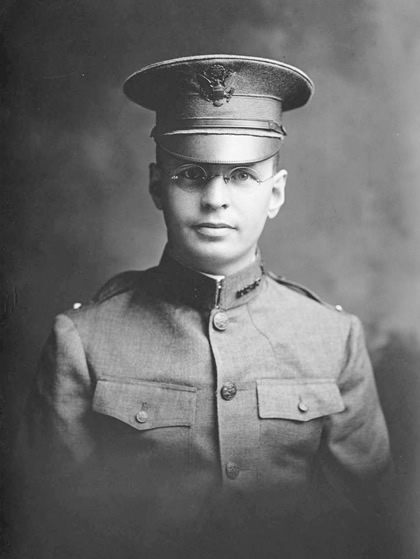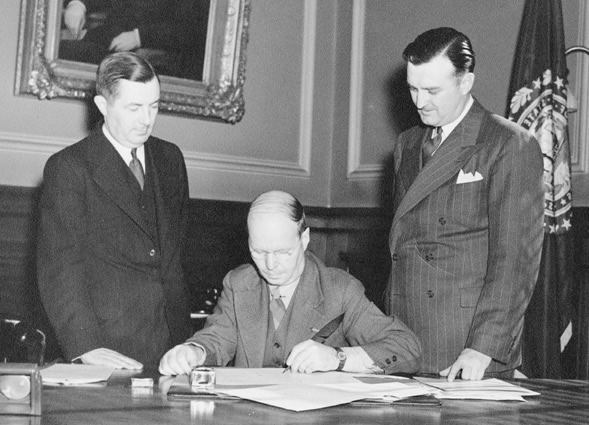Citizens of Concord have served with distinction in our armed forces throughout the history of our city and nation. Charles H. Willey is Concord’s only Congressional Medal of Honor recipient in the 20th Century for his bravery and heroism aboard the U.S.S. Memphis which blew up in Santo Domingo Harbor in 1916. Lt. Commander Roy H. Benson, Navy Cross and Gold Star recipient, was was awarded a second Gold Star for his attack in 1943 on the aircraft carrier Hiyo, flagship of the commander of the Japanese navy. Benson was commanding the submarine U.S.S. Trigger. Second Lieutenant Chet Wheeler was awarded the Distinguished Service Cross for his heroic efforts, while leading his platoon in the battle to re-take the Alaskan island of Attu from the Japanese in May, 1943. Wheeler was seriously wounded in the battle for “Massacre Valley.” Thirteen women performed yeoman service in operating a World War II sawmill to salvage an estimated 12-million board feet of white pine blown down in the Hurricane of 1938 from Turkey Pond. They liked to be called “The Lumber Jills of Turkey Pond.” In July, 1944, Army Air Force First Lieutenant Armante ‘Rick” D’Amante bailed out of his fatally stricken B-24 Liberator while on a bombing run over Linz, Austria. He was captured by German soldiers and spent the rest of the war in a P-O-W camp. These are but a few of the inspiring stories about Concord residents serving in and for the service of our country as told in Byron Champlin;s “Called to the Colors” Chapter 10 of Crosscurrents of Change: Concord, N.H. in the 20th Century. Here is an excerpt from that chapter, telling the story of Robert O, Blood,, M.D., World War I battle surgeon and Governor of New Hampshire during World War II.
Robert O. Blood, M.D.: Fearless healer, fearless leader
By Byron O. Champlin
Robert O. Blood, owlish in wire-rimmed glasses, made an unassuming soldier.
As a 30-year-old surgeon, Blood went to France with the Yankee Division in 1917, adding heroism in combat to his many talents and skills. The son of a railroad worker and farmer, Blood skipped college and worked his way through Dartmouth Medical School by painting college buildings and by driving the stagecoach that transported visitors from the local railroad station.
Blood, a first lieutenant in the Medical Corps, was attached to the 103rd Infantry around Chateau Thierry in July 1918. The Yankee Division counterattacked the Germans at the Aisne-Marne salient, crossing a broad plateau cut by deep ravines and swept by German machine gun fire. Blood advanced with the assaulting troops on July 18, establishing aid stations, tending the wounded and evacuating them.

Casualties were severe: “Almost at every stride some comrade fell, stumbling forward lifeless, or falling to [catch his] wind and rock for a while through the first disordering sting of a fatal wound,” one survivor reported.
On July 20, Blood treated the casualties in an exposed ravine. His advanced aid station was unprotected, “except by a slight bank on each side” and was “heavily shelled with high explosives and a few mustard gas shells.”4 Two medics working with him were wounded. Another went to the rear with shell shock, his nerves shattered. After nightfall, Blood scrambled forward with a pair of first aid men and several litter bearers, and, under the relentless fire, worked until midnight locating and evacuating the wounded. The next day was much the same. On July 22, Blood treated the wounded in Breteuil Woods, under such intense shelling that his aid station moved four times in twenty-four hours. In three days, Blood and his team treated and evacuated more than 500 men.
“I want to give Blood all the credit that is coming to him,” Lieutenant John A. Rogers wrote home to Concord. “He was absolutely fearless and did wonderful work. He went over the top with his battalion, and took care of the wounded under a murderous machine gun fire.”
First Lieutenant Robert O. Blood was awarded the Distinguished Service Cross and the French Croix de Guerre, for “working untiringly under heavy enemy fire at all times, superintending the evacuation of the wounded and caring for them in the most dangerous and exposed positions.” When he was sent to a rear echelon posting in August, the commander of his battalion reported that Blood “has been with me in the trenches and in attacks and is not only one of the best military surgeons, but one of the bravest men I have ever known.” He added ruefully, “it seems a sad misfortune that this officer’s talents should be wasted in the rear where he is now going when good men are so badly needed at the front.”
Discharged as a major at war’s end, Blood was elected a national vice commander of the American Legion upon its founding in 1922. When war came again to Concord, it found Blood had added political leadership to his skills as a surgeon and dairy farmer. Blood served as New Hampshire’s governor with foresight, frugality and tempered leadership from 1941 to 1944.
Almost a year before Pearl Harbor, Governor Blood enacted a state defense program. A law setting up a State Council of Defense, based on a federal model, was signed on April 4, 1941, and a week later Blood proclaimed a state of emergency, bringing the state council into existence.
Blood initiated New Hampshire’s unit of the Ground Observer Corps of the federal Aircraft Warning Service in July 1941, and by August 1 observation posts were set up at seven-mile intervals, organized and staffed by the American Legion. This network was activated immediately after Pearl Harbor.
The morning after Pearl Harbor, Governor Blood convened the executive committee of the State Defense Council and gave the state adjutant general authority to oversee public safety “in all its phases.” Blood warned New Hampshire citizens that a surprise attack upon New England was “now no more unlikely, nor less possible, than the sudden attack upon Hawaii.”
Concord’s first night-time blackout drill was on March 18, 1942, and the governor observed the exercise from the State House dome. The results, he reported, “gave vivid proof that Concord citizens realize what we are up against, and are prepared to do their part.”
Blood maintained a full-time surgical practice as he used the governorship to focus public attention on the war effort.
He called for church bells to toll on the first anniversary of Pearl Harbor,12 and at Christmas 1943 he urged a curb on revelry, observing that families would find “one or more empty chairs at almost every fireside and table.”

In October 1943, the War Department closed the state’s airplane spotter posts, but Blood kept the civilian air-raid warning system functioning twenty-four hours a day. “Recent military successes do not mean that the war is nearly won, or that the end is in sight,” the governor cautioned. Among the spotters freed for other volunteer duty by the move was the governor’s wife, Pauline.
Blood maintained a busy schedule throughout the war. On his fifty-seventh birthday in 1944, the governor rose before 7 a.m. to perform surgery, was in his State House office by 10, and late that afternoon traveled to Amherst, Massachusetts, for a speech to the New England Ayrshire Breeders Association, of which he was a member.
Blood frequently interceded with the War Department on behalf of New Hampshire citizens, particularly the wives and mothers of servicemen. Madeline Laramie, of Franklin, whose husband was in the Marines, complained in September 1944 that her family allotment checks had stopped arriving. “I have 3 small children and expect another in Oct.,” she wrote. “The Red Cross here said they can’t help me more, and my bills are behind and I have no money to eat, either.” Within weeks, Mrs. Laramie received a check for arrears payments and her allotments arrived again. Denied a third term by his Republican Party, Blood retired from the governor’s office in January 1945. Despite the war, he had reduced the state’s debt by almost $7 million.
Robert O. Blood died in 1975 and is buried at Blossom Hill Cemetery.
You can read more about Concord in the 20th century by buying a copy of Crosscurrents of Change: Concord, N.H. in the 20th Century. Order your copy including shipping on this website at http://concordhistoricalsociety.org/store/Books-c3944607
or get your copy in Concord at the Greater Concord Chamber of Commerce, 49 South Main Street, or Gibson’s Bookstore at 45 South Main Street.
Keep checking our website for future excerpts fromCrosscurrents of Change.They will appear periodically. The next excerpt will be from the chapter of the book entitled “Tidings of Faith.”
